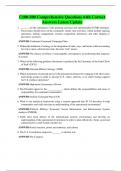C100 -500 Comprehensive Questions with Correct Answers Latest Update 1. _______ are the centerpiece of the planning construct and operationalize CCMD strategies. These plans should focus on the command's steady -state activities, which i nclude ongoing operations, military engagement, security cooperation, deterrence, and other shaping or preventive activities. ANSWER -Combatant Command Campaign Plans 2. Within the definition of strategy as the integration of ends, ways, and means while acco unting for risk to meet a desired end state, the term "risk" means: ANSWER -The chance of failure or unacceptable consequences in performing that sequence of actions 3. Which of the following guidance documents is produced by the Chairman, of the Joint Chief s of Staff (CJCS)? ANSWER -National Military Strategy (NMS) 4. Which instrument of national power is the principal instrument for engaging with other states and foreign groups in order to advance U.S. values, interests, or to solicit foreign support for U.S. military operations? ANSWER -Diplomatic Instrument of Power 5. The President approves the ____________, which defines the responsibilities and areas of responsib ility for combatant commanders. ANSWER -Unified Command Plan (UCP) 6. What is one analytical framew ork using a systems approach that JP 3 -0 describes to help commanders and staffs develop an understanding of the operational environment? ANSWER -Political, Military, Economic, Social, Information, and Infrastructure System Analysis (PMESII) 7. Staffs must ke ep abreast of the international security environment and develop an understanding of the operational environment in order to plan effectively. Some social and cultural fact ors a staff would consider are: ANSWER -Social structure, power and authority, and c ulture 8. The U.S. Constitution empowers _______ to declare war. ANSWER -The Congress 9. What are the three key national security policy advisory councils to the President of the United States? ANSWER -The National Security Council (NSC), the Homeland Security Council (HSC), and the National Economic Council (NEC) 10. Commanders link ends, ways, and means to achieve the desired end state. In this construct the term "ways" is defined as: ANSWER -A sequence of actions that is likely to achieve stated objectives 11. In the context of strategy formulation, the questions of feasibility, acceptability, and suitability are really questions about the validity of a given strategy. Which of the following questions best defines the concept of acceptability? ANSWER -Acceptability : Do the expected benefits of attaining the objectives outweigh the potential consequences or costs? 12. Which document produced by the Chairman of the Joint Chiefs of Staff translates strategic policy end states from the CPG into military campaign and conting ency plan guidance? ANSWER -Joint Strategic Campaign Plan (JSCP) 13. Commanders link ends, ways, and means to achieve the desired end state. In this construct the term "ends" is defined as: ANSWER -The objectives that must be achieved to enable a strategic o r national objective 14. In the context of strategy formulation, the questions of feasibility, acceptability, and suitability are really questions about the validity of a given strategy. Which of the following questions best defines the concept of suitability? ANSWER -Suitability: will the strategy protect/advance the national interest, attain the desired ends, and not work against other national -level goals? 15. Commanders link ends, ways, and means to achieve the desired end state. In this construct the term "me ans" is defined as: ANSWER -Resources that are required to accomplish a sequence of actions 16. ________ is the principal military adviser to the President, the National Security Council, and the Secretary of Defense as designated by the Goldwater -Nichols Dep artment of Defense Reorganization Act of 1986. ANSWER -The Chairman of the Joint Chiefs of Staff (CJCS) 17. Which of the following guidance documents is signed by the Secretary of Defense? ANSWER -National Defense Strategy (NDS) 18. When using a Political, Milita ry, Economic, Social, Information, and Infrastructure (PMESII) system analysis the most important aspect of this analysis is: ANSWER -Describing the relevant relationships within and between the various systems that directly or indirectly affect the probl em 19. Which best describes jus ad bellum (justice of going to war)? ANSWER -Going to war for the right reasons, as a last resort, with a reasonable hope for success and with legitimate authority 20. The ways nations use power available to exercise control over p eople, places, things, and events to achieve objectives while accounting for risk is: ANSWER -A strategy 21. What instrument of national power uses action that is planned or executed, word that is written or spoken, and images that are displayed or relayed in focused efforts to create, strengthen, or preserve conditions favorable for the advancement of the national interest, policies, and objectives by understanding and engaging key audiences? ANSWER -Informational Instrument of Power 22. In the context of strate gy formulation, the questions of feasibility, acceptability, and suitability are really questions about the validity of a given strategy. Which of the following questions best defines the concept of feasibility? ANSWER -Feasibility: Can the strategic end be achieved with the resources available, or attainable? 23. The Joint Strategic Planning System (JSPS) is how the Chairman of the Joint Chiefs of Staff carries out statutory responsibilities to assess the environment, advise senior leaders, provide direction to the armed forces, and execute directions from the President and the SECDEF. Which of the following is a JSPS product? ANSWER -The Joint Strategic Campaign Plan (JSCP) 24. In order to visualize an approach to solving a problem, a commander must: ANSWER -Describe the operational environment in both its current state and in its desired end state at the conclusion of operations. 25. The joint doctrine instruments of national power are: ANSWER -Diplomatic, Informational, Military, Economic 26. __________ includes the authority to task -organize subordinate forces, assign missions and functions, and geographic responsibilities to forces. ANSWER -Operational control (OPCON).




